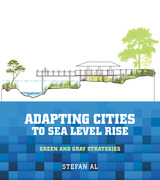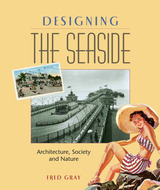2 books about Seaside architecture

Adapting Cities to Sea Level Rise
Green and Gray Strategies
Stefan Al
Island Press, 2018
In 2012, Hurricane Sandy floods devastated coastal areas in New York and New Jersey. In 2017, Harvey flooded Houston. Today in Miami, even on sunny days, king tides bring fish swimming through the streets in low-lying areas. These types of events are typically called natural disasters. But overwhelming scientific consensus says they are actually the result of human-induced climate change and irresponsible construction inside floodplains.
As cities build more flood-management infrastructure to adapt to the effects of a changing climate, they must go beyond short-term flood protection and consider the long-term effects on the community, its environment, economy, and relationship with the water.
Adapting Cities to Sea Level Rise, by infrastructure expert Stefan Al, introduces design responses to sea-level rise, drawing from examples around the globe. Going against standard engineering solutions, Al argues for approaches that are integrated with the public realm, nature-based, and sensitive to local conditions and the community. He features design responses to building resilience that creates new civic assets for cities. For the first time, the possible infrastructure solutions are brought together in a clear and easy-to-read format.
The first part of the book looks at the challenges for cities that have historically faced sea-level rise and flooding issues, and their response in resiliency through urban design. He presents diverse case studies from New Orleans to Ho Chi Minh to Rotterdam, and draws best practices and urban design typologies for the second part of the book.
Part two is a graphic catalogue of best-practices or resilience strategies. These strategies are organized into four categories: hard protect, soft protect, store, and retreat. The benefits and challenges of each strategy are outlined and highlighted by a case study showing where that strategy has been applied.
Any professional or policymaker in coastal areas seeking to protect their communities from the effects of climate change should start with this book. With the right solutions, Al shows, sea-level rise can become an opportunity to improve our urban areas and landscapes, rather than a threat to our communities.
As cities build more flood-management infrastructure to adapt to the effects of a changing climate, they must go beyond short-term flood protection and consider the long-term effects on the community, its environment, economy, and relationship with the water.
Adapting Cities to Sea Level Rise, by infrastructure expert Stefan Al, introduces design responses to sea-level rise, drawing from examples around the globe. Going against standard engineering solutions, Al argues for approaches that are integrated with the public realm, nature-based, and sensitive to local conditions and the community. He features design responses to building resilience that creates new civic assets for cities. For the first time, the possible infrastructure solutions are brought together in a clear and easy-to-read format.
The first part of the book looks at the challenges for cities that have historically faced sea-level rise and flooding issues, and their response in resiliency through urban design. He presents diverse case studies from New Orleans to Ho Chi Minh to Rotterdam, and draws best practices and urban design typologies for the second part of the book.
Part two is a graphic catalogue of best-practices or resilience strategies. These strategies are organized into four categories: hard protect, soft protect, store, and retreat. The benefits and challenges of each strategy are outlined and highlighted by a case study showing where that strategy has been applied.
Any professional or policymaker in coastal areas seeking to protect their communities from the effects of climate change should start with this book. With the right solutions, Al shows, sea-level rise can become an opportunity to improve our urban areas and landscapes, rather than a threat to our communities.
[more]

Designing the Seaside
Architecture, Society and Nature
Fred Gray
Reaktion Books, 2009
In Alfred Hitchcock’s To Catch a Thief, a seaside resort was the setting for thievery and intrigue. Fred Astaire and Ginger Rogers tap-danced their way to fame at a Brighton resort in The Gay Divorcee. The seaside resort has always held a special fascination, a place of containment and leisure that has a unique form in the physical landscape: towering hotels, shop-lined boardwalks, and sprawling beaches. Fred Gray delves into the history of seaside architecture here in Designing the Seaside, writing the rich and international story of the seaside resort’s diverse structures from the eighteenth century through today.
Gray is interested not only in the physical structures but also the cultural mores they represent—the “yearly holiday,” and our attitudes about leisure. The coastal landscape has been transformed by this geography of relaxation, and Gray considers the physical and cultural shifts that occurred when shops, boardwalks, and hotels buried sand dunes and marshes beneath their beams. He examines the design processes that went into creating the diverse buildings and spaces within a seaside resort, giving full attention to ephemeral structures such as pavilions and summer gift shops as well as the trademark hotel buildings, fairgrounds, and open spaces. Designing the Seaside also reveals how events such as beauty pageants made seaside resorts into sites of debate over conflicted issues of sexuality and morality.
Drawing on a diverse array of historical material—photographs, guidebooks, postcards, and posters—Fred Gray offers a fascinating account of the cultural and social symbolism of the seaside resort and its role in the modern landscape.
Gray is interested not only in the physical structures but also the cultural mores they represent—the “yearly holiday,” and our attitudes about leisure. The coastal landscape has been transformed by this geography of relaxation, and Gray considers the physical and cultural shifts that occurred when shops, boardwalks, and hotels buried sand dunes and marshes beneath their beams. He examines the design processes that went into creating the diverse buildings and spaces within a seaside resort, giving full attention to ephemeral structures such as pavilions and summer gift shops as well as the trademark hotel buildings, fairgrounds, and open spaces. Designing the Seaside also reveals how events such as beauty pageants made seaside resorts into sites of debate over conflicted issues of sexuality and morality.
Drawing on a diverse array of historical material—photographs, guidebooks, postcards, and posters—Fred Gray offers a fascinating account of the cultural and social symbolism of the seaside resort and its role in the modern landscape.
[more]
READERS
Browse our collection.
PUBLISHERS
See BiblioVault's publisher services.
STUDENT SERVICES
Files for college accessibility offices.
UChicago Accessibility Resources
home | accessibility | search | about | contact us
BiblioVault ® 2001 - 2024
The University of Chicago Press









